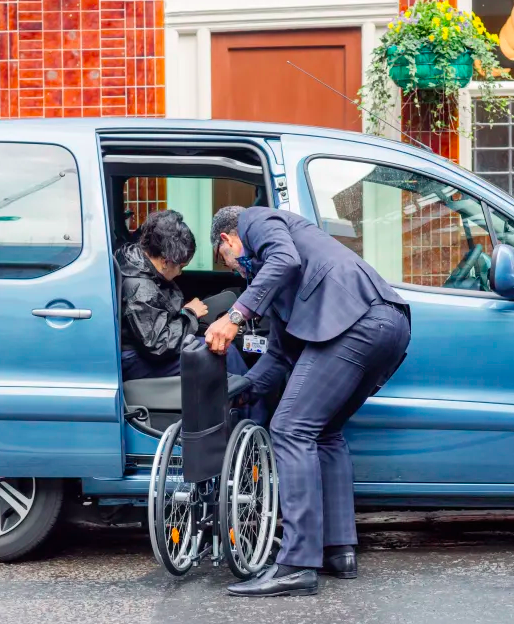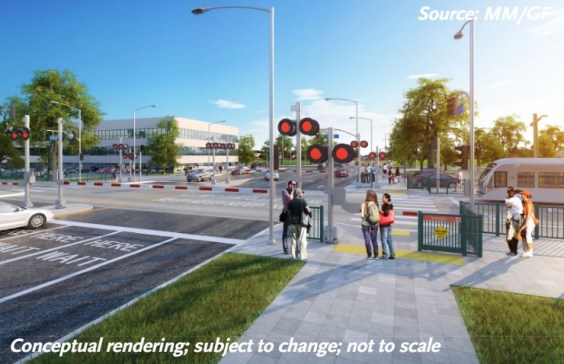The Controversy Over How to Regulate Wheelchair Service by Uber and Lyft in California
3:17 PM PDT on August 18, 2022

Image via Uber
The state of California is working to ensure that people who use wheelchairs and need wheelchair-accessible vehicles (WAVs) can easily access ride-hailing services such as Uber and Lyft. The California Public Utilities Commission (CPUC) develops rules and regulations for ride-hailing vehicles - and has been responsible for administering a program to improve WAV access since lawmakers passed S.B. 1376 in 2018. This law requires ride-hailing companies to charge riders a fee, which ride-hailing companies can use to invest in improving WAV service.
The CPUC hosts an ongoing discussion about program administration and rulemaking among ride-hailing companies, disability advocates, and other stakeholders; based on these discussions, it makes further rules which have the force of law. Issues at stake include how to continuously improve standards to make sure that customers who need WAVs can get rides and don’t face unfair treatment such as cancellations or very long waits for pick-ups. The CPUC also administers the pool of money, called the Access for All Fund, that comes from the ten-cent fees added to every ride-hail ride (not just to WAV rides). The purpose of this fund is to help all ride-hailing companies improve and increase WAV services. Getting more WAVs into service would improve ride availability and reduce wait times for wheelchair riders. (For more background on this law and the ensuing regulations, see this December 2021 Streetsblog California article.)
In December 2021, a group jointly referred to as Disability Advocates (comprising Disability Rights California, the Disability Rights Education & Defense Fund, and the Center for Accessible Technology) asked the CPUC to rehear a previous decision from a month earlier which had set “performance-based standards'' for WAV services that would allow ride-hailing companies to avoid paying the ten-cent fee to the CPUC for a limited period of time. The request was based on a dispute over legal terms and definitions used to set performance-based standards. The CPUC rejected this request. We’ll unpack some of the thorny legal details of this dispute, discuss who supports the rehearing request, and speak to some of the outstanding questions that the state needs to resolve to advance WAV ride-hailing accessibility.
The Dispute
The CPUC set standards for reducing response times for WAV ride-hailing passengers, but Disability Advocates are concerned that the law passed in 2018 and the regulatory decision from 2021 may be in conflict. In their rehearing request, Disability Advocates quote the California statute:
As part of the designated level of WAV service for each geographic area, the CPUC shall require a [ride-hailing company], at a minimum, to have response times for 80 percent of WAV trips requested via the [company’s] online-enabled application or platform within a time established by the commission for that geographic area.
(Emphasis added to indicate that the word "requested" plays a key role in the legal controversy.)
Meanwhile, in its recent decision, the CPUC says,
To qualify for an exemption, a [ride-hailing company] must demonstrate that: (a) 80 percent of its completed wheelchair accessible vehicle (WAV) trips met or exceeded the corresponding Level 1 Offset Response Time Benchmarks for a given geographic area for four consecutive quarters, and (b) The [ride-hailing company] qualified for an offset in the given geographic area for the same four consecutive quarters.
(Again, emphasis added.)
Disability Advocates argue that requested trips are not the same as completed trips, given that trip cancellations are a major grievance among WAV ride-hailing passengers. They make the case that CPUC, in choosing to regulate wait times only for completed trips, has watered down the statute.
The CPUC ruling says that ride-hailing companies only have to complete a certain percentage of requested trips to be eligible for exemptions from the ten-cent fees; that percentage varies by county and over time, but even the most stringent requirement, in San Francisco County starting two years from now, is 75 percent. However, if only 75 percent of requested trips need to be completed, and 80 percent of those completed trips must meet wait-time requirements, that means that only 60 percent of overall requested trips must be completed within that waiting time. This percentage would be even lower in other counties.
Disability Advocates argue that the CPUC’s lower standard violates the law by going against the language of S.B. 1376, which states that 80 percent of overall requested trips need to be completed within the specified waiting time, not 60 percent or lower.
Recent Developments
The CPUC rejected the Disability Advocates’ request for several reasons. In their June 2022 decision to deny the rehearing request, the CPUC first pointed to a procedural issue. The definitions in dispute in S.B. 1376 had already been established in previous decisions, and the CPUC requires any disputes to be resolved at the time that such decisions are made. Disability Advocates didn’t dispute those definitions then, so now, says the CPUC, it is too late to renew the dispute and redefine codified legal definitions.
Second, the CPUC justified basing the standards on trips completed by considering a different part of the statute. S.B. 1376 also states that ride-hailing companies have to provide information about WAV rides that includes detailed data on response time "between when a WAV ride was requested and when the vehicle arrived.” The CPUC interprets this to mean that a WAV ride only has a well-defined response time (wait time) if the WAV ride is requested and the vehicle arrives. The CPUC already requires that ride-hailing companies complete minimum percentages of requested rides, and that at least 80 percent of completed rides meet minimum response time benchmarks. Thus, the CPUC argues that if a ride never arrives, that would already count against the ride-hailing company’s exemption request in the context of trip completion requirements. These should not also count against the company’s request in the context of response times, because non-arrivals would not have “response times.”
Meanwhile, Disability Advocates recently submitted a counter argument, making the case that even if trip requests that are never completed by definition don’t have response times, the statute requires that at least 80 percent of WAV trip requests have a response time. This would mean not only that at least 80 percent of all requested trips must be completed, but also that enough of those completed trips must have response times that satisfy set benchmarks.
Thus, Disability Advocates argue, trip requests that are never completed must count against the 80 percent standard for WAV trip requests.
Who Is on Which Side
Apart from Disability Advocates and the CPUC, a handful of organizations who are officially part of this rulemaking have taken sides in this dispute. A group of agencies in San Francisco (specifically the San Francisco Mayor’s Office on Disability, the San Francisco Municipal Transportation Agency, and the San Francisco County Transportation Authority), Marin Transit, the San Francisco Taxi Workers Alliance, the Metropolitan Transportation Commission, and the Los Angeles County Metropolitan Transportation Authority have all written in support of Disability Advocates’ position. Uber has written in support of the CPUC's position.
Almost all of the letters in support of Disability Advocates focus exclusively on the statutory language involving the term “requested,” saying that CPUC is watering down the standard from 80 percent to 60 percent or less, as Disability Advocates argue. Only one of the letters in support of the Disability Advocates, namely the one by the San Francisco Taxi Workers Alliance, addresses the other part of S.B. 1376, which requires data “detailing the response time between when a WAV ride was requested and when the vehicle arrived.” That letter claims that this wording doesn’t actually define a response time, but does not justify this claim nor provide any alternative definitions.
Uber’s letter in support of the CPUC also does not address the definition of a trip “response time.” It limits its argument to claiming that the word “requested” only refers to how the WAV trips are requested. That letter then claims that the key requirement applies only to “response times for 80 percent of WAV trips” and that interpreting this in plain language means considering trips, which must be completed, separately from trip requests.
Outstanding Questions
Like many legal disputes, this one hinges on legal definitions and interpretations. Many terms that seem to have intuitive everyday meanings, such as “trips” and “response times,” need more careful definitions in legal contexts. There are a few open questions that could crystallize some of these disputes over language.
- Does a “trip” need to be completed to be defined as a trip?
- Would it be more fair if a “trip” were counted as incomplete if the driver is the one to cancel the trip? If instead the rider cancels the request, would it be better to not count it as a “trip”?
- Is it possible to say that the “response time” for a trip request that isn’t completed because of a driver cancellation or no-show is infinite?
- Can a single “trip” have multiple cancellations, by riders or drivers, before it is completed or discarded? If so, how would it be counted under the CPUC’s standards? (Note: The CPUC is currently considering this very question in the same rulemaking process.)
- Is the combination of the CPUC’s trip completion standards and time-based standards for completed trips enough to ensure that ride-hailing companies whose drivers consistently cancel WAV trip requests cannot qualify for exemptions from fees? Alternatively, should exemptions require more stringent time-based standards involving 80 percent of WAV trips requested, with those trips that are canceled by drivers or are no-shows being counted as having infinite response times?
- Does the language in S.B. 1376 about trips being “requested via the [ride-hailing company’s] online-enabled application or platform” mean that trips requested via telephone are not counted toward a company’s exemption qualification? This could be relevant especially in rural areas where internet access is less common, so ride-hailing companies that want to operate in those areas may have to give riders the option of booking rides by telephone.
These nuanced questions point out that there are many devilish details still to address in order to comprehensively improve WAV accessibility in ride-hailing. All parties to the CPUC proceeding seem committed to ensuring that riders who need WAVs are treated more equitably, and that ride-hailing companies work to get more WAVs in service, more trip requests, more completed trips, and shorter wait times. The debate over how exactly to accomplish this will continue.
Prashanth Venkataram is a postdoctoral researcher at the Institute of Transportation Studies at UC Davis. Mollie Cohen D’Agostino is the Policy Director for the UC Davis Policy Institute for Energy, Environment, and the Economy and Co-Director of the new UC Davis Mobility Science Automation and Inclusion Center (MOSAIC).
Streetsblog California editor Melanie Curry has been thinking about transportation, and how to improve conditions for bicyclists, ever since commuting to school by bike long before bike lanes were a thing. She was Managing Editor at the East Bay Express, editor of Access Magazine for the University of California Transportation Center, and earned her Masters in City Planning from UC Berkeley.
Read More:
Stay in touch
Sign up for our free newsletter
More from Streetsblog California
California Leaders Celebrate Ten Years of Climate Action
Air Resources Board report highlights progress funded by the California Cap-and-Trade Program
How Car-Centric Cities Make Caring For Families Stressful — Particularly For Women
Women do a disproportionate share of the care-related travel their households rely on — and car-focused planning isn't making matters easier.
A Very Ferry Future. Plus Advocates Call BS on ‘Welcoming West Portal Committee’
A whole lot more ferry service proposed for the Bay Area
Wednesday’s Headlines
Cash incentives can change transportation habits; Safer streets need investment; Suburbs don't want to support public transit; Depaving; More
San Fernando Valley Bus/Bike Updates: G Line, Roscoe Bus Lanes, Laurel Canyon Bike Lanes
Short newly protected bike lane on Laurel Canyon Blvd, extensive NSFV bus improvements under construction this month, and scaled-back G Line plans should get that project under construction this summer




